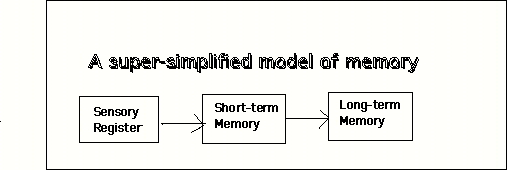

YET ANOTHER COGNITIVE DEVELOPMENT IN EARLY CHILDHOOD AND BEYOND
The model of memory below, an even more simplified one
than the version in your book, illustrates some very important concepts
 |
 |
The sensory register is just that, where information
registers on your senses. For example, a butterfly passes flies in front
of you as you are walking to the college, another person passes you, walking
in the opposite direction, there is green grass on the lawns on either
side of you, the road underneath is hard with occasional pieces of gravel,
birds are chirping, a car horn honks in the distance, you can smell the
bacon cooking in someone's house as you pass by, geese are flying overhead,
your sweater is tight around your waist. Every waking hour, we are bombarded
with stimuli - sights, sounds, smells, touches - everything from the sensation
of your clothes against your body (which you may be thinking about now
for the first time in weeks!) to your baby's first step. The great majority
of that information never even makes it past a brief consciousness.
 |
Two experiments on the sensory
register and short term memory.
I used to do this experiment in my college classes to demonstrate how information registers on the senses and yet does not make it in to short term memory. I would have a student walk into the classroom, hand me a sheet of papers, make some comment about "Here are the papers you wanted" and then leave. Immediately, I would turn to the class and say, "Write down on a piece of paper the color of shirt and shoes the person had on." About half of the class (or less) would remember the person's shirt color, and usually 10% or less could remember the shoe color - despite the fact that they had all seen what the student was wearing and less than 10 seconds would have passed between when the person walked out of sight and they were asked to recall the colors. Try this experiment on someone you know (Frank
de la Paz is a good one to play tricks on - or any of those Project Drive
people!).
For the second experiment, you need to scroll down the page. Move down until the words "STOP HERE" written in bold letters below are at the top of the page. |
STOP HERE --- To do the second experiment, keep
scrolling until these words are at the top of the page.
Now... without looking back up, answer the following questions:
In the picture to the left of the description of the
experiments, there were beakers of liquids.
1. How many beakers were there?
2. How many different colors of liquids were there?
3. Name the colors.
The point (and I do have one) is that while a great deal of information is sensed by the average person, only a small fraction receives enough attention to make it even into short-term memory.
Speaking of short-term memory, the next box in our figure (which I have reproduced below so as not to tax your short-term memory)

is just that, short-term memory. Short-term memory has very limited capacity. Only a very few pieces of information at a time can be held in short-term memory. You have probably had this experience in several contexts.
Examples of failures to move from short-term to long-term
memory:
Both of these examples, or something very similar,
have probably happened to you. Both demonstrate that short-term memory
can hold only a very small amount and for a very short time. When something
else enters your short-term memory, whatever was in there previously, such
as a phone number, is lost.
Developmental changes in information processing
Well, I could go on for hours, and give many more
examples, but we DO need to at some point move on to the subject of social
development, so, let's do that now, right after the quiz.
Click here to take a quiz on cognitive development in early childhood.
Click here to go on to the next section of the course - social development in early childhood.
Click here to return to the home page.
Click here for the hell of it. It doesn't go anywhere.
NOTE: I am aware that I did not discuss at all either gender roles (we will cover that in the next section - social development in early childhood) nor intelligence (we will cover that in the section of the course on cognitive development in middle childhood). Both of those topics are relevant and important. I just thought they fit more logically somewhere else in the course.